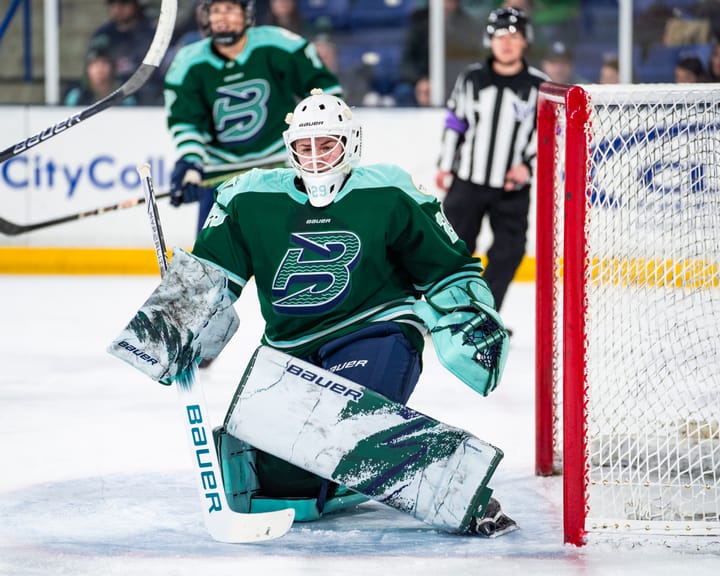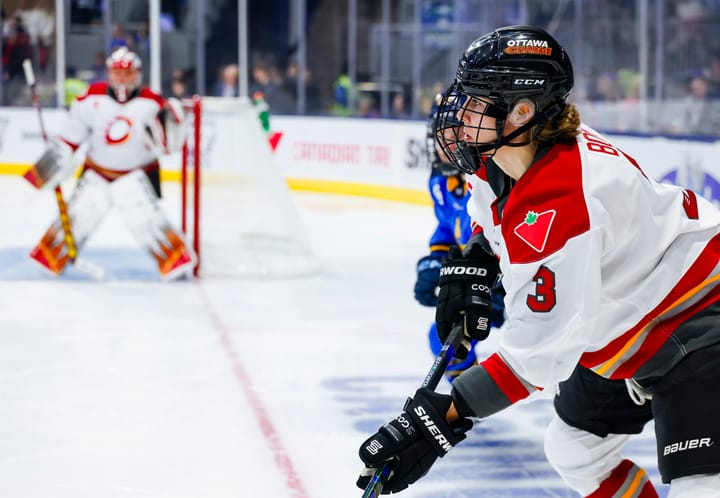Making the case that Riikka Sallinen is the GOAT
Finland’s greatest Lioness
Hockey Canada icon Hayley Wickenheiser is widely considered to be the greatest player in the history of women’s hockey — especially among North American fans, players, and analysts. The recent Hockey Hall of Fame inductee challenged the public’s perception of what women could accomplish in ice hockey both during and after her storied playing career.
“Wick” set numerous records, was the beating heart of a dynasty for Team Canada that captured four consecutive Olympic gold medals, and broke new ground by playing professional men’s hockey in Europe. She’s responsible for inspiring countless young Canadian girls to pick up a hockey stick for the first time. For many, she set the standard for greatness in the sport — regardless of gender. However, there is a case to be made that she may not be the greatest player of all time.
Finnish center Riikka Sallinen has been underrated and underappreciated by North American fans and hockey media in four different decades. When women’s hockey first grabbed the attention of sports media at the 1998 Olympics in Nagano, Team USA’s and Team Canada’s rosters both had a bevy of stars and numerous future Hall of Famers. Finland, on the other hand, had one star who stood out from the rest. Sallinen’s preeminence served as the guiding light for Naisleijonat and, arguably, for all of Nordic and European hockey.
The big stage
The Olympics and the top division of the Women’s World Championship are the two biggest stages in women’s hockey.
Team success and individual excellence at these tournaments carries more weight than achievements made at the collegiate and professional levels. Of course, the Olympics matters more because it means so much more to the world of sport. Since the Nagano Games in 1998, the women’s Olympic tournament has held a place of reverence. It is a singular event that has played a vital role in the growth of the game. It has also served as the crucible from which greatness can emerge.
The Olympics and Worlds are significant not only because of their history and the high volume of talent on the ice, but also because they have proven to be highly marketable. The world takes notice when you succeed at one of these two major tournaments.
Wickenheiser is not only the all-time leader in Olympic scoring, she’s also the leader in Pts/GP among skaters who have played at least 16 games in the tournament. She won five Olympic medals with Canada and was named the Best Forward and MVP in Salt Lake City and Torino. In other words, she changed the game and the world — largely through North American media — took notice.
Despite all of that, there is a case to be made that the title of “GOAT” could belong to another. In Nagano, it wasn’t Wickenheiser or Team USA icon Cammi Granato who led all skaters in scoring with the world watching; it was Sallinen.
The lady lion
Before the Nagano Games, Sallinen had already established herself as one of the best players on the planet.
She scored 46 points in 20 games of Worlds competition (1990, 1994, 1995, 1997) before the 1998 Olympics and was named the Best Forward of the 1994 Worlds. In the 1997 Worlds, she scorched the competition with five goals and five assists in five games to lead all skaters in scoring. That year, she made history as the first woman to be named a Top-3 Forward in three consecutive Worlds tournaments.
A cerebral, crafty center with superb hands, Sallinen was the fire blanket that Finland relied on to counter elite North American and Swedish centers. Finland leaned on their two-way superstar to counter juggernauts like Wickenheiser, Jayna Hefford, Granato, and Jenny Potter. However, Sallinen was also counted on to generate offense.
She is the highest-scoring European-born player in Worlds and Olympic history even though she missed two Olympics and 11 Worlds due to injury and an early retirement. Take a moment to process that last sentence. She missed two Olympics and 11 Worlds in the prime of her career and still finished with two Olympic and seven Worlds medals.
After scorching the competition with seven goals and five assists in six games in Nagano, Sallinen missed the next three years of Worlds competition with a knee injury that required surgery and proved to be a “headache” that kept her off the ice. She’s also recently shared that concussions had a major impact on her career.
Sallinen competed in the 2002 Olympics but picked up just three assists in five games. Following that tournament, Sallinen would not return to play for Team Finland in a major international tournament until the 2014 Sochi Olympics. During that window she started her family and was inducted into the IIHF Hockey Hall in recognition of all she had achieved and her contribution to women’s hockey.
In 2014, the mother of three laced up her skates, came out of retirement, and added several more chapters to her unbelievable story. Her initial plan to come out of retirement to lead Team Finland in the 2014 Olympics turned into six more seasons of professional and international hockey.
Undeterred by Finland’s fifth-place finish at the Sochi Games, Sallinen collected two bronze medals at the 2015 and 2017 Worlds before capturing her second Olympic bronze medal in PyeongChang at the age of 44. The following year, she made history with Finland by biting into the country’s first-ever silver medal at the 2019 Worlds — which was a controversial goalie interference call away from being a gold.
Peerless in twilight
Remember, Sallinen was 40 when she competed in the 2014 Olympics and 45 when Finland won silver at the 2019 Worlds. Her technical skill was so respected when she was in her mid-40s that she averaged 22:05 TOI/GP at the 2018 Olympics and 19:58 TOI/GP — second among Finland’s forwards — at the 2019 Worlds. Make no mistake, she earned every bit of that ice time with her play.
If we combine her play in Worlds and Olympic competition to give us a larger sample size in her return to the game, Sallinen averaged 0.78 Pts/GP in 37 games from the 2014 Olympics to the 2019 Worlds. To put that number into context, Cassie Campbell-Pascall averaged 0.82 Pts/GP in Olympic and Worlds competition combined and she was recently singled out by Elliotte Friedman as a strong candidate to be the next woman inducted into the Hockey Hall of Fame.
Of course, measuring production isn’t the only way to measure greatness, it’s just the most convenient. However, there’s a lot more to Sallinen’s greatness than the longevity of her career and her knack for generating offense. She is a singular figure in the history of Naisleijonat and in Finnish sports in general. At the beginning of the millennium Canada had Wickenheiser, the United States had Granato, and Finland had Sallinen (then Riikka Nieminen).
There is perhaps no better way to comprehend Sallinen’s place in the history of Finnish hockey than to look at the logo for the IIHF 2019 Women’s World Championship. The logo was designed by the multitalented star Finnish forward Michelle Karvinen. If you look closely at the shadow that the skater casts on the ice, you’ll notice the number “13” — that is there as an homage to Sallinen. Finland’s roster at the 2019 Worlds was filled with players who grew up idolizing and revering No. 13.
Related
Team Finland legend Riikka Sallinen retires
Filling in the blanks
Now, let’s get back to the numbers. It’s only natural to wonder what Sallinen’s career totals would look like if she hadn’t missed so many tournaments as a result of injury and early retirement. As things stand, she’s currently tied for seventh with Natalie Darwitz and Hockey Hall of Famer Danielle Goyette (25 points).
When we apply the scoring rate that Sallinen posted in her 40s in major tournaments (0.75) and her scoring rate in Olympic competition (1.09) we can project that she would have piled up somewhere in the neighborhood of 8–9 points. So, if she stayed healthy, she likely would have caught Jenny Potter, who is second all-time in Olympic scoring with 32 points (in 21 GP).
It’s important to remember that Finland finished fourth and third, respectively, in the only two Olympics they have played without the greatest center in the history of the national team. So there would have been considerable talent around her. It’s also vital to note that using all-strengths scoring rates in the small sample sizes of Olympic and Worlds competition is less than ideal.
All things considered
The mastery of Sallinen is all the more impressive when we consider the teams she played for relative to the talent that filled the ranks for Team USA and Team Canada. The bottom line is that players like Wickenheiser, Potter, and Granato had more talent around them than Sallinen did. To be clear, that statement is not meant to discredit their achievements or insult Naisleijonat players of years past. It is meant to provide crucial context.
More than any other player on Naisleijonat, Sallinen was the engine that brought Finland to a bronze in Nagano and bronze medals in each of the first four IIHF Women’s Worlds. With her two-way play and fearless approach, Sallinen demanded respect not just for herself and Finland, but for European hockey since the very first Worlds in 1990. Her superb performances served as a protest not only to those who were quick to detract the women’s game, but also to those who failed to look at the game beyond the borders of Canada and the United States.
Sallinen was inducted into the IIHF Hall of Fame in 2010 and inducted into the Finnish Hockey Hall of Fame in 2007, but she has never been a household name in North America in the way that Wickenheiser, Granato, Angela Ruggiero, Hilary Knight, or Marie-Philip Poulin have been. However, she wasn’t on Hockey Night in Canada breathing fire into the greatest rivalry in team sports and was never on a box of Wheaties or in an EA Sports NHL video game.
Of course, a label like “the greatest” is a subjective one, especially when you go beyond the things we can quantify. With that being said, it’s all-too-revealing that Sallinen has seldom been mentioned by North American sports media in the same breath as Wickenheiser or Granato. It’s also all-too-revealing — and profoundly disappointing — that we are still waiting for the first European-born woman to be inducted into the HHOF. That player should be Sallinen, and she should not have to wait until 2022. She and Wick are and were both worthy of “exceptional status” for their contributions to the game.
Sallinen should forever be counted among the small pantheon of legends who brought women’s hockey to the world during the 1990s. She is by no means the only great player to play for Finland, but she is undoubtedly the most influential and most important to the program. In a sport that is defined by its trailblazers, Sallinen’s hockey story and career are both peerless.





Comments ()